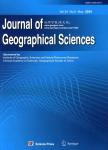全球升温1.5度和2度情景下“一带一路” 区域干燥指数时空演变
Spatiotemporal variations of aridity index over the Belt and Road region under the 1.5℃ and 2.0℃ warming scenarios作者机构:Collaboration Innovation Center on Forecast and Evaluation of Meteorological Disasters/Institute for Disaster Risk Management/School of Geographical ScienceNanjing University of Information Science&TechnologyNanjing 210044China National Climate CenterChina Meteorological AdministrationBeijing 100081China State Key Laboratory of Desert and Oasis EcologyXinjiang Institute of Ecology and GeographyCASUrumqi 830011China University of Chinese Academy of SciencesBeijing 101408China
出 版 物:《Journal of Geographical Sciences》 (地理学报(英文版))
年 卷 期:2020年第30卷第1期
页 面:37-52页
核心收录:
学科分类:0709[理学-地质学] 07[理学] 070601[理学-气象学] 0706[理学-大气科学] 0704[理学-天文学]
基 金:国家973计划 Chinese-Pakistan cooperative project jointly funded by NSFC and PSF The CMA Climate Change Science Fund
主 题:1.5℃and 2.0℃global warming scenarios aridity index spatial and temporal variations the Belt and Road region
摘 要:Aridity index reflects the exchanges of energy and water between the land surface and the atmosphere,and its variation can be used to forecast drought and flood patterns,which makes it of great significance for agricultural *** ratio of potential evapotranspiration and precipitation is applied to analyse the spatial and temporal distributions of the aridity index in the Belt and Road region under the 1.5℃and 2.0℃global warming scenarios on the basis of outputs from four downscaled global climate *** results show that:(1)Under the 1.5℃warming scenario,the area-averaged aridity index will be similar to that in 1986-2005(around 1.58),but the changes vary *** aridity index will increase by more than 5%in Central-Eastern Europe,north of West Asia,the monsoon region of East Asia and northwest of Southeast Asia,while it is projected to decrease obviously in the southeast of West *** the seasonal scale,spring and winter will be more arid in South Asia,and the monsoon region of East Asia will be slightly drier in summer compared with the reference ***,West Asia will be wetter in all seasons,except winter.(2)Relative to 1986-2005,both areal averaged annual potential evapotranspiration and precipitation are projected to increase,and the spatial variation of aridity index will become more obvious as well at the 2.0℃warming *** the aridity index over the entire region will be maintained at approximately 1.57 as that in 1.5℃,the index in Central-Eastern Europe,north of West Asia and Central Asia will grow rapidly at a rate of more than 20%,while that in West Siberia,northwest of China,the southern part of South Asia and West Asia will show a declining *** the seasonal scale,the increase of the aridity index in Central-Eastern Europe,Central Asia,West Asia,South Asia and the northern part of Siberia in winter will be obvious,and the monsoon region in East Asia will be drier in both summer and autumn.(3)Under the scena



